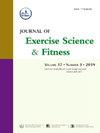中老年人体力活动变化与肌肉减少症风险之间的关系
IF 2.4
2区 医学
Q2 SPORT SCIENCES
引用次数: 0
摘要
目的:本研究旨在利用中国全国代表性人群的数据,确定中老年人体力活动变化与肌肉减少症风险之间的纵向关系。方法共纳入2831例患者,男性44.5%,女性55.5%,平均年龄(61.86±9.33岁)。根据2011年至2015年间身体活动的变化,参与者被分为活跃到活跃(A-A, n = 1367)、不活跃到活跃(I-A, n = 455)、活跃到不活跃(A-I, n = 553)和不活跃到不活跃(I-I, n = 456)组。肌少症和肌少症风险指标是根据亚洲肌少症工作组2019年共识确定的。采用单因素方差分析、协方差分析和逻辑回归分析来确定体力活动变化与肌肉减少症风险之间的关系。结果a - a组、I-A组、a - i组和I-I组的握力有显著性差异,行走速度和5次椅站测试有显著性差异(p <;0.05)。我组相比,sarcopenia的可能性是很低(OR: 0.65, 95% CI: 0.52—-0.81)和我(OR: 0.67, 95% CI: 0.51—-0.87)组,可怜的肌肉力量的可能性是很低(OR: 0.61, 95% CI: 0.50—-0.76)和我(OR: 0.65, 95% CI: 0.50—-0.83)组,和低速率的物理性能是很低(OR: 0.33, 95% CI: 0.26—-0.41),我(OR: 0.38, 95% CI: 0.29—-0.50)和ⅰ(OR: 0.55, 95% CI:控制协变量后,0.43-0.71)组。结论保持或进行体育锻炼的中老年人群发生肌肉减少症、肌力差、体能低下的风险较低。相反,那些停止运动的人患肌肉减少症、肌肉力量差和身体表现不佳的风险更高。本文章由计算机程序翻译,如有差异,请以英文原文为准。
Association between changes in physical activity and sarcopenia risk in middle-aged and older adults
Objectives
This study aimed to determine the longitudinal relationship between the changes in physical activity in middle-aged and older persons and sarcopenia risk utilizing data from a nationally representative population in China.
Methods
This study included 2831 participants (44.5 % men, 55.5 % women, mean age 61.86 ± 9.33 years). Participants were divided into active to active (A-A, n = 1367), inactive to active (I-A, n = 455), active to inactive (A-I, n = 553), and inactive to inactive (I-I, n = 456) groups based on changes in physical activity between 2011 and 2015. Sarcopenia and sarcopenia risk indicators were determined using the Asian Working Group for Sarcopenia 2019 consensus. One-way analysis of variance, analysis of covariance, and logistic regression analyses were used to determine the association between the changes in physical activity and sarcopenia risk.
Results
Handgrip strength tended to have a significant difference, and walking speed and 5-time chair stand test had significant differences among the A-A, I-A, A-I, and I-I groups (all p < 0.05). Compared to the I-I group, the likelihood of sarcopenia was lower in the A-A (OR: 0.65, 95 % CI: 0.52–0.81) and I-A (OR: 0.67, 95 % CI: 0.51–0.87) groups, the likelihood of poor muscle strength was lower in the A-A (OR: 0.61, 95 % CI: 0.50–0.76) and I-A (OR: 0.65, 95 % CI: 0.50–0.83) groups, and the rate of low physical performance was lower in the A-A (OR: 0.33, 95 % CI: 0.26–0.41), I-A (OR: 0.38, 95 % CI: 0.29–0.50) and A-I (OR: 0.55, 95 % CI: 0.43–0.71) groups after controlling for covariates.
Conclusions
Middle-aged and older people who remain or become physically active have a lower risk of sarcopenia, poor muscle strength, and low physical performance. Conversely, those who stop being physically active have a higher risk of sarcopenia, poor muscle strength, and low physical performance.
求助全文
通过发布文献求助,成功后即可免费获取论文全文。
去求助
来源期刊
CiteScore
5.10
自引率
3.60%
发文量
54
审稿时长
31 days
期刊介绍:
The Journal of Exercise Science and Fitness is the official peer-reviewed journal of The Society of Chinese Scholars on Exercise Physiology and Fitness (SCSEPF), the Physical Fitness Association of Hong Kong, China (HKPFA), and the Hong Kong Association of Sports Medicine and Sports Science (HKASMSS). It is published twice a year, in June and December, by Elsevier.
The Journal accepts original investigations, comprehensive reviews, case studies and short communications on current topics in exercise science, physical fitness and physical education.

 求助内容:
求助内容: 应助结果提醒方式:
应助结果提醒方式:


